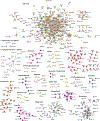Decoding the Foodome: Molecular Networks Connecting Diet and Health
- PMID: 39207880
- PMCID: PMC11610447
- DOI: 10.1146/annurev-nutr-062322-030557
Decoding the Foodome: Molecular Networks Connecting Diet and Health
Abstract
Diet, a modifiable risk factor, plays a pivotal role in most diseases, from cardiovascular disease to type 2 diabetes mellitus, cancer, and obesity. However, our understanding of the mechanistic role of the chemical compounds found in food remains incomplete. In this review, we explore the "dark matter" of nutrition, going beyond the macro- and micronutrients documented by national databases to unveil the exceptional chemical diversity of food composition. We also discuss the need to explore the impact of each compound in the presence of associated chemicals and relevant food sources and describe the tools that will allow us to do so. Finally, we discuss the role of network medicine in understanding the mechanism of action of each food molecule. Overall, we illustrate the important role of network science and artificial intelligence in our ability to reveal nutrition's multifaceted role in health and disease.
Keywords: artificial intelligence; complexity; machine learning; network medicine; network science; nutrition; systems pharmacology.
Figures










Similar articles
-
Molecular Interaction Networks and Cardiovascular Disease Risk: The Role of Food Bioactive Small Molecules.Arterioscler Thromb Vasc Biol. 2023 Jun;43(6):813-823. doi: 10.1161/ATVBAHA.122.318332. Epub 2023 Apr 27. Arterioscler Thromb Vasc Biol. 2023. PMID: 37128923 Review.
-
Dietary glycation compounds - implications for human health.Crit Rev Toxicol. 2024 Sep;54(8):485-617. doi: 10.1080/10408444.2024.2362985. Epub 2024 Aug 16. Crit Rev Toxicol. 2024. PMID: 39150724
-
The Computational Diet: A Review of Computational Methods Across Diet, Microbiome, and Health.Front Microbiol. 2020 Apr 3;11:393. doi: 10.3389/fmicb.2020.00393. eCollection 2020. Front Microbiol. 2020. PMID: 32318028 Free PMC article. Review.
-
Role of Artificial Intelligence in Multinomial Decisions and Preventative Nutrition in Alzheimer's Disease.Mol Nutr Food Res. 2024 Jul;68(13):e2300605. doi: 10.1002/mnfr.202300605. Epub 2024 Jan 4. Mol Nutr Food Res. 2024. PMID: 38175857 Review.
-
Artificial Intelligence Applications to Measure Food and Nutrient Intakes: Scoping Review.J Med Internet Res. 2024 Nov 28;26:e54557. doi: 10.2196/54557. J Med Internet Res. 2024. PMID: 39608003 Free PMC article.
Cited by
-
Analytically Unsupervised Metabolomic Profile of the Premium Malgasy Pepper Voatsipérifery (Piper borbonense): Identification of Marker Components.J Agric Food Chem. 2025 Apr 23;73(16):9854-9866. doi: 10.1021/acs.jafc.5c01501. Epub 2025 Apr 11. J Agric Food Chem. 2025. PMID: 40215346 Free PMC article.
-
Prevalence of processed foods in major US grocery stores.Nat Food. 2025 Mar;6(3):296-308. doi: 10.1038/s43016-024-01095-7. Epub 2025 Jan 13. Nat Food. 2025. PMID: 39806219
-
GroceryDB: Prevalence of Processed Food in Grocery Stores.medRxiv [Preprint]. 2025 Jan 16:2022.04.23.22274217. doi: 10.1101/2022.04.23.22274217. medRxiv. 2025. Update in: Nat Food. 2025 Mar;6(3):296-308. doi: 10.1038/s43016-024-01095-7. PMID: 38883708 Free PMC article. Updated. Preprint.
-
Rethinking Depression-Beyond Neurotransmitters: An Integrated Psychoneuroendocrineimmunology Framework for Depression's Pathophysiology and Tailored Treatment.Int J Mol Sci. 2025 Mar 19;26(6):2759. doi: 10.3390/ijms26062759. Int J Mol Sci. 2025. PMID: 40141399 Free PMC article. Review.
References
-
- Afendi FM, Okada T, Yamazaki M, Hirai-Morita A, Nakamura Y, et al. 2012. KNApSAcK family databases: integrated metabolite–plant species databases for multifaceted plant research. Plant Cell Physiol. 53(2):e1. - PubMed
-
- Aguilera JM. 2019. The food matrix: implications in processing, nutrition and health. Crit. Rev. Food Sci. Nutr 59(22):3612–29 - PubMed
-
- Alonso-Pedrero L, Ojeda-Rodríguez A, Martínez-González MA, Zalba G, Bes-Rastrollo M, Marti A. 2020. Ultra-processed food consumption and the risk of short telomeres in an elderly population of the Seguimiento Universidad de Navarra (SUN) Project. Am. J. Clin. Nutr 111(6):1259–66 - PubMed
-
- Int AOAC. 2023. Official Methods of Analysis of AOAC International, Vols. 1–2. Washington, DC: Oxford Univ. Press. 22nd ed.
Publication types
MeSH terms
Grants and funding
LinkOut - more resources
Full Text Sources

